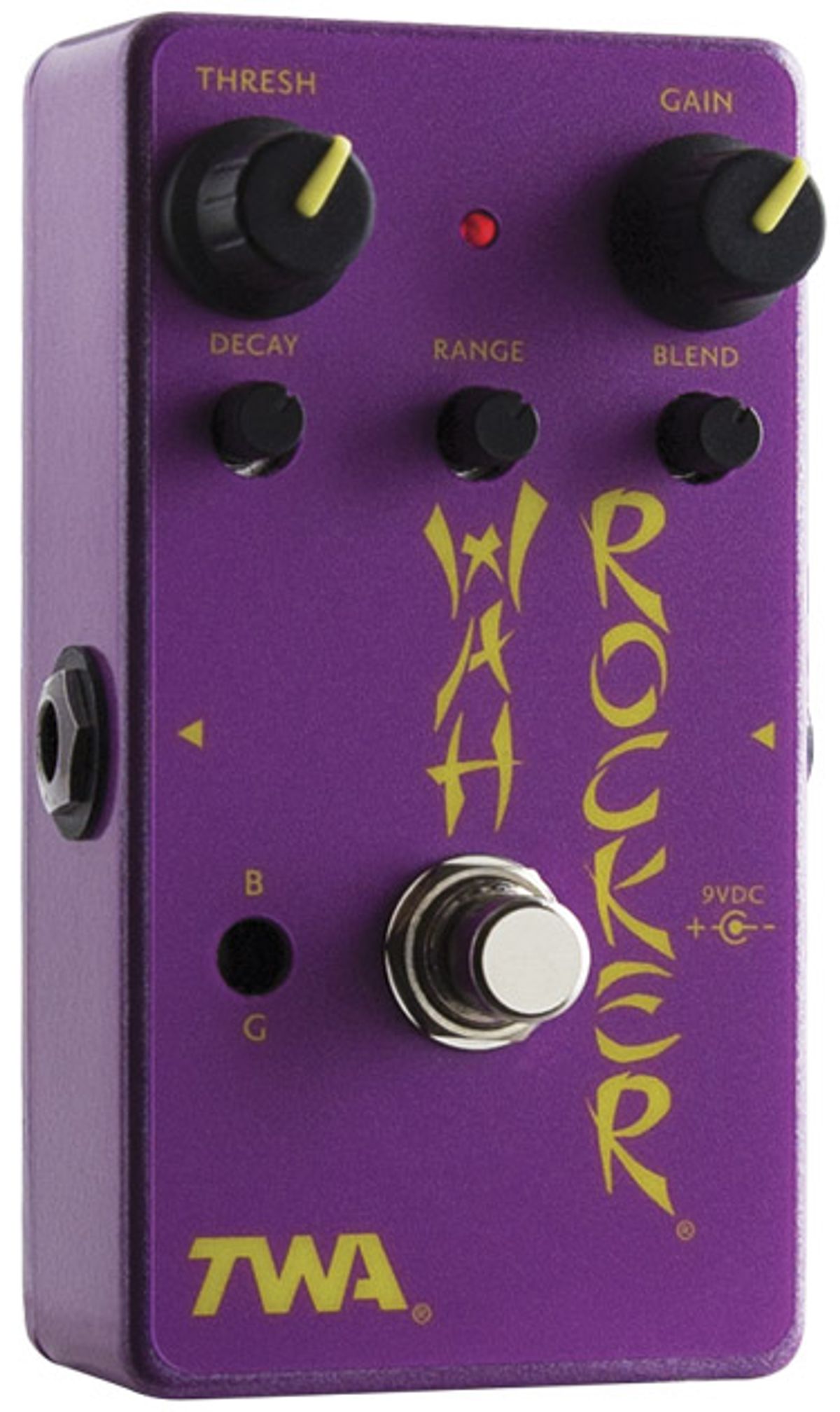
This new take on the vintage Guyatone WR3 Wah Rocker provides transportation to Funkytown for bassists and guitarists.
Clip 2 (Guitar) - Recorded with a Fender Strat and a Vox AC30 - Guitar setting engaged, threshold at noon, decay at 7 o'clock, gain at 7 o'clock, blend at noon, range at 1 o'clock.
The “Duck Box,” a/k/a the original Guyatone WR3 auto wah, is universally regarded as a hidden gem within the funky world of envelope filtering. In response to the pedal’s skyrocketing demand in the vintage market, the team at TWA (Totally Wycked Audio) has developed a handbuilt re-creation of the sought-after funk box. TWA’s WR-3 Wah Rocker boasts the same core circuitry as the original, but includes improvements for more versatility and extended range—for both bass and guitar.
Duck ’n’ Cover
Compared to the original Guyatone WR3, the road-worthiness of the TWA WR-3 is on an entirely different level. It’s in a rugged die-cast enclosure that’s blanketed with a powder-coated purple paint job, while the underside is protected by a 4-screw die-cast plate instead of the original’s piece of pull ’n’ peel rubber. The enclosure houses a completely analog circuit with TWA’s relay-based, S3 true-bypass circuitry.
There are controls for threshold and gain, along with a trio of mini pots for setting the filter’s decay time, the frequency range in which the filter is sweeping, and the wet/dry blend. The blend function is a notable upgrade over the original, which was limited to 50/50 blending only. There’s also a switch for flipping between guitar and bass modes. The latter introduces changes to the circuit tailored after Guyatone’s Bottom Wah Rocker.
Wah-Mazing Bass
With the WR-3 in bass mode, I demoed the pedal using a Lollar-equipped Fender P through a Gallien-Krueger 400RB/Ampeg 8x10 pairing. Starting out with the threshold, range, and blend at noon, and the gain and decay at their minimums, the pedal unleashed a thoroughly funky wah tone with good depth and a quick sweep. Its responsiveness to fingerstyle dynamics was nothing short of fantastic. The threshold control allowed me to fine-tune the sensitivity to a point where I could relax and instinctively trigger the effect without having to think about it.
Ratings
Pros:
Solid build. Capable of vintage WR3 tones and beyond. Modes for bass and guitar.
Cons:
Mode switch requires a tool to reach/switch. Extreme ends of range control can sound harsh or muffled.
Tones:
Ease of Use:
Build/Design:
Value:
Street:
$189
TWA WR-3 Wah Rocker
godlyke.com
Finding the majority of the WR-3’s coolest sounds—fast synth-like sweeps, bowel-shaking low-end, or revolving ’70s auto-wah—depends heavily on the position of the pedal’s range control. Turning it clockwise makes the effect brighter and seemingly louder, but without adding any harsh crispness. The filter develops a darker tone when the dial is moved counterclockwise, as the range is gradually limited to the lower frequencies—yielding a tone akin to a fully cocked-back wah pedal.
I found myself tweaking the range dial about 80 percent of the time, and then using the other controls to fine-tune. I also avoided moving the range knob below 9 o’clock or above 3 o’clock, which typically muddied up the filter with too much low end or made it sound like a shrieking bird with too much high-end emphasis.
So how did the TWA WR-3 fare with a guitar? Pretty damned well. The filtering in guitar mode sounded clear and bold with a Fender Strat and Vox AC30 combination, and the pedal’s gain control was quite handy for compensating for low-end loss when using the Strat’s bridge pickup. The blend control’s extreme transparency allowed me to dial in very warm auto-wah sounds that accentuated the Strat’s crisp, dry tone—from the 50/50 mix offered by the original WR3 to plenty more on either side.
The Verdict
For players lusting after an original WR3, the TWA WR-3 might be, in many ways, a better choice. Its enclosure is tougher, it offers the same tones as the vintage model, and it boasts new capabilities that greatly expand upon the discontinued pedal’s tonal palette. For auto-wah enthusiasts and fans of all things funky—guitar or bass—the TWA WR-3 is kind of a no-brainer.
